Wanna learn how to monetize a blog? Great!
So do 10,001 other bloggers, and it is NOT always easy 😉
Sooooo many bloggers see the Pat Flynns and Darren Rowses of the world making $100k/month…and end up frustrated…
Well there’s luck –>
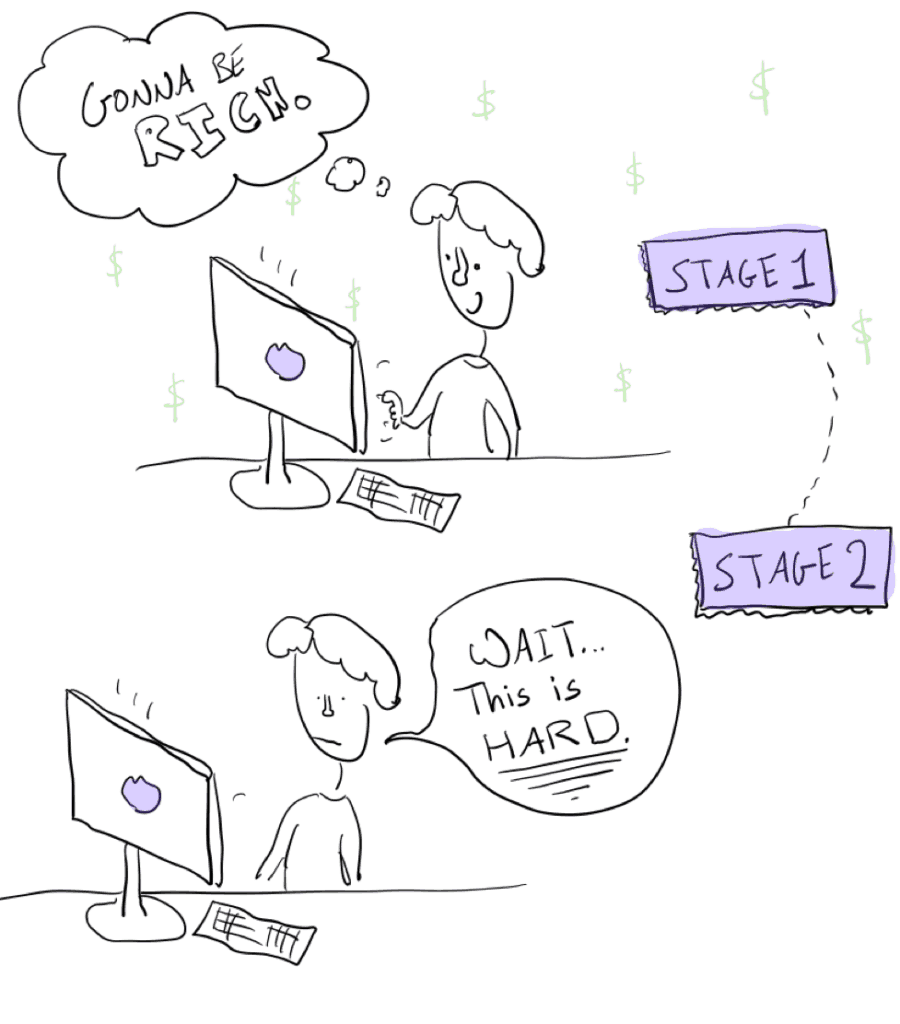
Below is a TON of ways to monetize a website with ads, affiliate marketing, online courses, virtual summits, etc…
…as well as practical tools & resources to help you start earning in no time.
Yes, every blogger CAN make money from their website.
It’s just a matter of patience, hard work, and learning.

This post covers the learning.
Boom. 🔥
There are a few required ingredients for making money on the internet.
Don’t skip these!

If you want to monetize a blog, your learning will be for NOTHING without the following:
1 – A valuable niche
A lawn maintenance site will NOT be as lucrative as a book review site. (Who buys lawn stuff online? Nobody.)
The blogging about blogging niche (I.e. what I’m doing right this second) is a VERY lucrative one, as people are willing to pay for info products to help them grow their blogs.
Do people buy stuff online in your niche?
2 – Amazing content
In order to make decent money from your blog, you’re going to HAVE to produce great content that matters to people. Period.
GROWING an audience depends on readers coming back for more. People don’t return to your site after they see crappy content.

There are several different ways, the most popular of which are:
The secret ingredient for ALL of these, however, is building a loyal and trusting following! (through blog traffic and an email list).
3 – A loyal community, following, and fans
Publishing products (or even ads) into a void obviously won’t monetize your blog.
You’ll need a following centered around your email list, as well as various social media platforms.
4 – Engagement!
More important than even website traffic….is engagement. Clicking, commenting, replying to emails, etc.
You want followers to not only glance at your site periodically…but be INVOLVED in your content, clicking affiliate links and purchasing ebooks because they’ve been around you long enough to TRUST your recommendations.
For our purposes…we’re talking about display ads (also called “banner ads”) and “native ads.”
Blog Ads = You earn a small amount of coin every time a website visitor *views* the ad, and a little MORE every time a visitor CLICKS an ad.
Check out this image of my friend Rich’s website, Meal Prepify. a food and cooking blog:
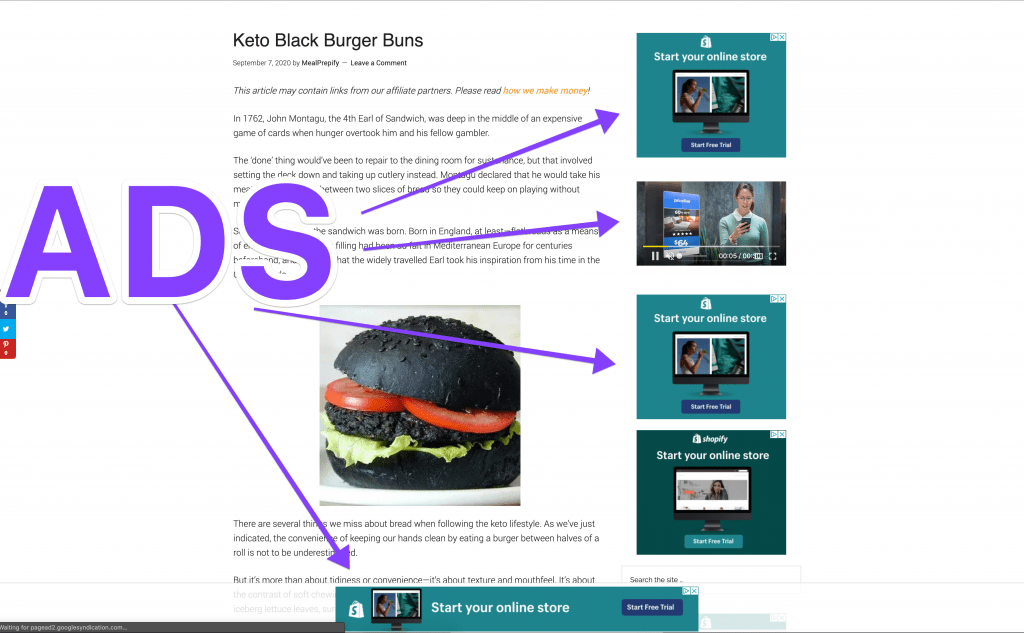
The ads you see are from an “ad network” called Ezoic (there’s a huge list of several of these companies below), and another popular one would be the famous Google Adsense.
Adsense is great for beginners but pays WAY less than other networks like Ezoic or Mediavine.

However, these better-paying networks often require a minimum of traffic! Mediavine requires 25k sessions per month (if you have that already…give them a try! People make a great income at that level).

For new bloggers with little website traffic, Google Adsense MIGHT bring a few dollars a month. For websites with 50k, 75k, 100k+ page views a month, they can make a few thousand dollars (like my friend John above)
Here’s how display ads work:
DYEB Recommends…
Don’t show display ads on your site until your traffic is sufficient to make real money. At that point, we recommend Mediavine!
They pay bloggers MORE money, straight up.
Additional RESOURCES
Here are a few more ad networks:
So, when we say “native ads,” we really just mean ads inserted within the content itself.

Technically, the law REQUIRES these ads to be labeled as ads, but they’re usually designed to blend in with the content.
All of the ad networks above ALSO insert ads in a native format, but you CAN turn them off if you find it an interruption to your readers 🙂 🙂
Affiliate link banner ads are our FAVE type of ad, for the obvious reason: we value our readers, and you should value your readers.
Affiliate marketing, used ONLY when the recommended products are a great fit for your readers, is a powerful way to make money from ads on your website.
We’ll talk about affiliate marketing in detail below, but you can always share aff links in an ad “format” as well!
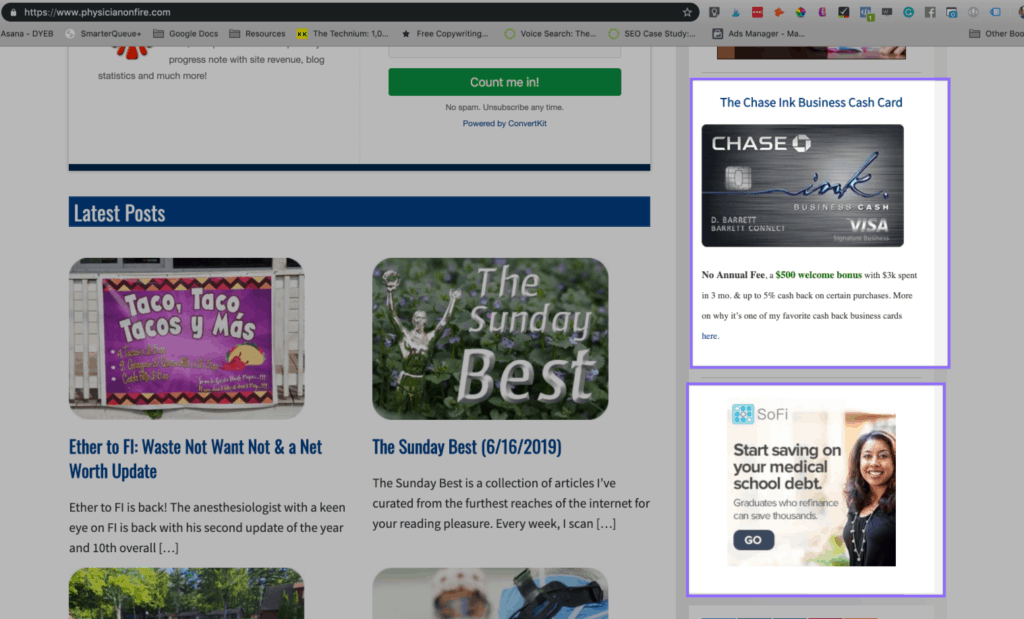
DYEB Recommends
Don’t spend a ton of time trying to DESIGN ads, ever. It’s not a great use of your time. However, DO grab pre-made banner ads from your favorite affiliate!
How to get started:
Almost ALL networks will offer pre-made affiliate banner ads.
You’ll almost ALWAYS find these in your affiliate dashboard, and they’ll GIVE you the HTML code to copy/paste into your blog.
I copied and pasted a code for my favorite marketing book from my Amazon Associates account below:
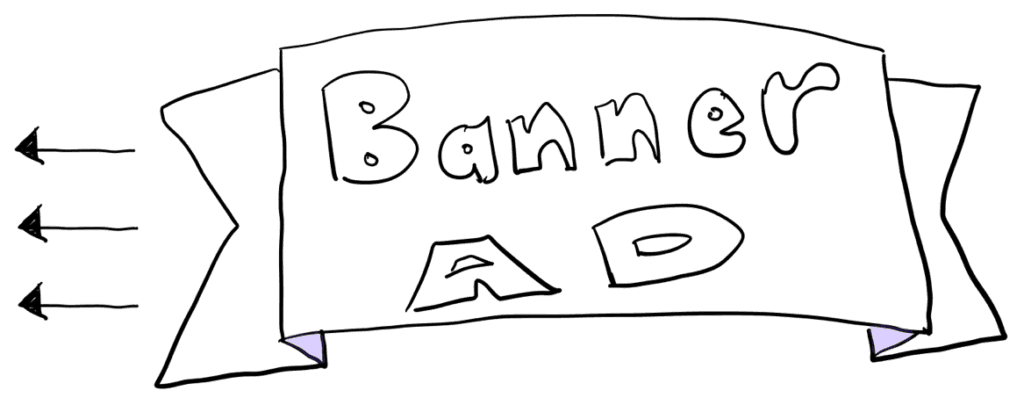
You retain control of the product ads you serve your visitors = GOLD. So much better than display ads, and likely more lucrative as well.
Affiliate marketing is the single most popular way to make money from a blog, for 3 reasons:
The first step is applying to affiliate programs for products you want to promote. Once accepted, you will grab a “special” or “unique” URL code that you can use to link to their product. When visitors click through your special link and buy the product, YOU EARN MONEY.
BY THE WAY….
TOOOOO many beginners take a “passive” approach to promoting affiliate links–rather than an “active” approach.
See this video for more info:
Here’s an example:
One of my favorite products to promote is Podia. They are THE go-to for bloggers who want to create and sell online courses, digital products, etc..
I applied to be a part of their affiliate program, and they gave me this special link:
https://www.podia.com/?via=pete
If you click on that link, then sign up for Podia, I’ll get 30% of whatever YOU pay them…every single month. Powerful!
This is mandatory for any aspiring affiliate marketer, as EVERYBODY has something to buy on Amazon. It’s great for all niches!
FAQ: How does it work? When somebody clicks through your Amazon affiliate link, they get a “cookie” stored in their browser (Google Chrome, etc)…and if they purchase any product (read that again…ANY product, not just what you linked them to) within the next 24 hours, you get paid a percentage of that!)
So if you link to this $19 Do You Even Blog T-shirt, and somebody clicks through but buys an $850 drone…YOU get a percentage of the price of the drone 🙂 🙂

DYEB Recommends
Sign up here for an affiliate account ASAP.
This is the most accessible affiliate program out there, and people TRUST buying on Amazon. It’s a fantastic way to promote products and earn extra money.
The idea is the same as Amazon above, but instead of your links leading to an Amazon page, they will lead to a specific company or product.
These networks contain THOUSANDS of different products and companies to choose from!
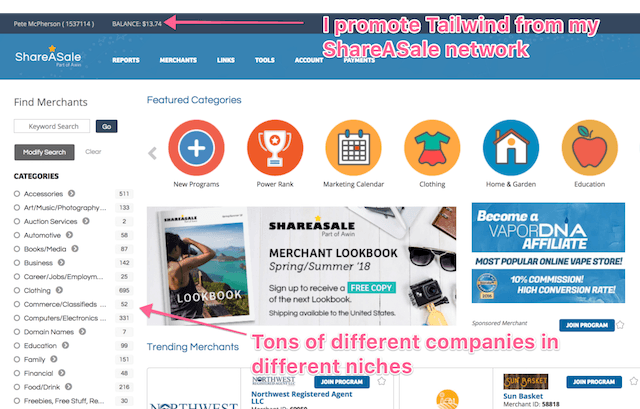
Note: Even though you get access to thousands to products through these networks…you’ll still have to “apply” to each affiliate separately. Don’t worry, you can do this THROUGH your network dashboard 🙂
DYEB Recommends
Start blogging, and when you DO start linking to products, apply to their aff programs at that time.
START by grabbing an Amazon Associates account, then start blogging regularly. In time, you will start linking out to other products/companies.
THEN go Google “[product name] affiliate,” and see if they have an affiliate program. Apply then. Don’t get overwhelmed trying to apply to 159 affiliate accounts at once.
Some products and companies aren’t a part of any affiliate networks, but they might have their affiliate programs hosted separately!
When I linked to Podia, that was through their own affiliate program (i.e. they’re not on Amazon).
Furthermore, many products have “refer a friend” type of campaigns, where they’ll give you a link, and either a bit of cash or free product for referring your friends!

SmarterQueue is my recommended social media tool, and it costs me $20 a month. However, when people sign up via my affiliate link here (which gets them a free month)…I get a free credit!
(Want to see more tried and tested blogging tools? Here’s my top recommendations.)
Pro Tip: Once you’ve been blogging a while, you’ll likely have a TON of affiliate links and dashboards to keep track of. We recommend creating a Google Sheets document and putting all of your links there (as well as links to your dashboard log-ins)
Here’s mine:
This just means you’ll be promoting other bloggers info products! (which we’ll talk A TON about below in the products section).
See that link above to Michelle’s affiliate marketing course? That’s my affiliate link, and when people buy the program through my link, I’ll make $67.
I have my own affiliate programs for Online Impact (my private membership community), and Podcourse (my podcast training), etc. 🙂

DYEB Recommends
If you’re a new blogger, you can’t just start applying to other bloggers’ products right away. Becoming affiliates for other bloggers’ products happens over time as a natural result of building blogging relationships.
However, they pay well. Typically 25%-40%. That’s over $200 PER REFERRAL for premium products like Podcourse and Online Impact.
Affiliate marketing = THEIR products and high profit margins.
Your digital products = YOUR high profit margins 😃
Some of this might be tough while you’re learning how to monetize a blog, and rightfully so: Creating your own products is advanced stuff.
Affiliate marketing means somebody else did the hard work of creating, designing, and launching products. Now it’s YOUR turn to do all that work.
HOWEVER, if you’re looking to grow a $100,000+ online business, it’s highly likely you’ll be leveraging your own products.
In fact…
This is my bread and butter at Do You Even Blog–and I have 3 main product funnels:
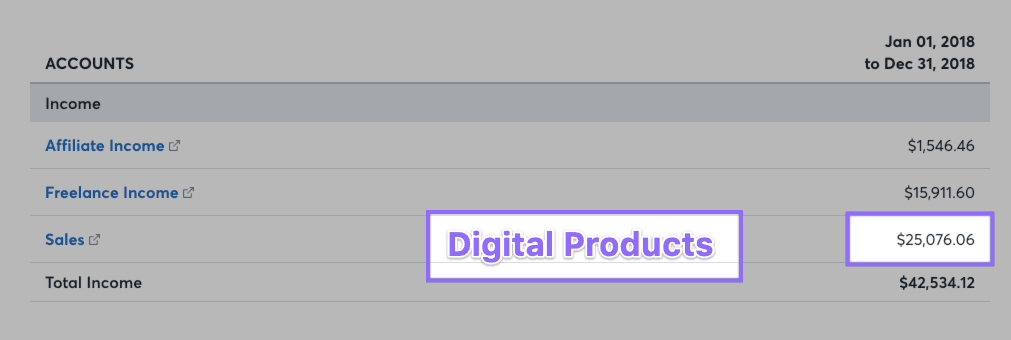
Good news though: Monetizing your website with your products doesn’t have to take months. You CAN make money from very simple but valuable products.
With HIGH profit margins too
Below are the BEST ways to make money from your blog without going back for an MBA or product design degree 😉
Ebook are just like regular books, except that ANYBODY can create and publish them…and they’re read via computer.
FAQ: What’s the best format for selling an ebook? The simplest way is to write via MS Word or a Google Doc, and export to PDF. BAM. Ebook! However, you can also publish to be read on people’s devices, such as Kindle. Then you can sell your ebook on Amazon!
My copywriter friend Liz Wilcox created a 40+ page PDF, and sells it in the sidebar to her website, bringing in several hundred dollars per month.

If you’ve been blogging for a while (and have built up a nice body of posts), you can also pull from content you’ve already written to fill out your ebook.
Pro Tip: Wondering what you could write that will actually SELL and make money? If you have access to your blog metrics, (which you should) you can sort all your blog posts by ‘most viewed’…and that will tell you WHICH pieces of content resonate the most with your readers. Create paid products based on THOSE topics!
DYEB recommends
Ebooks easy enough, especially is you’re utilizing free templates…but my guess is you’ll find them DIFFICULT to sell. Especially for decent money. (Have YOU ever paid more than $10 for an ebook? Seems rare).
The ebook would have to be EXTREMELY tasty and valuable. And even then, it’s a low ticket item compared to how much time you spend creating it.
If you want to teach people via a paid product, online courses are far more appropriate (and profitable) than ebooks.
So speaking of which, let’s learn how to monetize a blog via courses!
The 8/10 difficulty rating is the hardest and most intimidating for our uber ‘how to monetize a blog’ list. However, creating your own online course is STILL the highest ROI and most profitable website monetization strategy.
This is for three reasons:
Here’s Michelle Schroeder’s December 2017 monthly income report:

That’s crazy money.
When Bryan Harris had his FIRST product launch for his course 10K Subs, it made over $200k.

He now makes over $1M annually from that course.
Overwhelmed? You do NOT need to be making money from an online course like THESE people. It took them YEARS to build an audience that would bring that much revenue. You CAN get started TODAY.
You don’t need a huge audience or fancy & expensive software to start making money soon.
Only 3 months into THIS blog, with an email list of less than 400 people, I made over $1,500 from my first product launch (an online course).
How to get started:
First, here is a fantastic article on how to create online courses for your blog that monetize well, written by my friend Nick Loper from Side Hustle Nation.
Also, here’s a quick video I made:

Step 0 – Find a course idea.
This is actually the most important step by FAR. Whatever info product you create, it needs to be something REALLY DESIRABLE to your target reader! Something they want really bad.
Ask yourself: What problems or frustrations are my followers facing? What do they need help with? Which problems need MORE than a 1,300 word blog post to solve?
Step 1 – Pre-sale course BEFORE you build it
Why waste precious time and energy building an online course if you’re not COMPLETELY convinced that your readers will pay you money for it? What better way to validate a blog monetization idea that to actually ASK for money before you build it?
Pat Flynn from Smart Passive Income wrote a book called Will it Fly? which details this idea validation phase. Worth reading!
Step 2 – Choose a platform
I recommend Podia, only because it’s FREE to start with, and you can start creating content immediately, no set-up required. You can also create and sell products in online course directories like Udemy, or even host them on your own blog…but Teachable seems to be the best of both worlds.
Steps 3 and 4 – Build the course and launch it
This blog post on monetizing isn’t the place to detail this out, but launching online courses to make money isn’t a walk in the park.
In fact, it’s hard. Check out this blog post for more info on LAUNCHING products, specifically courses!
Overall, building an online course is probably the best way to monetize your blog, but it takes a massive amount of research, planning, building, and then selling. High ROI = lots of work.
FAQ: What IS a virtual summit? If a webinar is just you on video presenting (or maybe one guest), a summit is MULTIPLE videos with MULTIPLE presenters over a day or two.
Most summits are gathered around a specific topic, like my friend Chelsea’s virtual summit, “Mamas Talk Money,” which spans several days and features video presentations with well-known women in finance!

So here’s how a summit can monetize a blog:
DYEB Recommends
Not doing virtual summits, unless you have a TON of time to organize the event, as well as great connections (to get impressive speakers). It’s simply NOT a great return on investment outside of that. Learn how to monetize a blog in better ways.
You can actually sell content itself in different forms!
However, membership sites are easier said than done…
Ok, so TECHNICALLY, monetizing your blog from ebooks and courses IS selling content…but it’s just a different format.
The following monetization ideas are people JUST PAYING for your content in the totally normal way. I.e. blog posts! (or podcasts or videos).
Btw–I’ve made a REALLY quick video covering a toooon of blog sponsorship tips (It says podcasting, but 90% of the tips apply to blogging or brand sponsorships as well).
If the thought of emailing influencers or companies and straight up ASKING them for money scares you…this monetization strategy is not for you.
Kelan at The Savvy Couple routinely makes over $15,000-$25,000 a MONTH from sponsored posts.

However, you don’t necessarily NEED a huge reach and millions of visitors to get a sponsorships.
In my FIRST month blogging, I lined up two sponsors for $150. (more info here on that first month). I had literally NO views or downloads, and that more than paid for the first year’s website hosting, etc. #MONETIZE
Pro Tip: The key to obtaining sponsorships for your blog is A: finding people with enough money to pay, B: being upfront and honest with your intentions, and C: find the perfect balance of the value YOU provide THEM in exchange for the money they give you.
DYEB Recommends
It takes a certain amount of guts, persistence, and patience to pitch people or companies for sponsorships.
If you feel you have what it takes to deliver this type of value, and are comfortable pitching people and getting rejected, this is an EXCELLENT and quick way to monetize your blog. But be honest with yourself, if this isn’t you, move on to other methods!
Blackjack Apprenticeship keeps their good content behind a member’s only paywall:
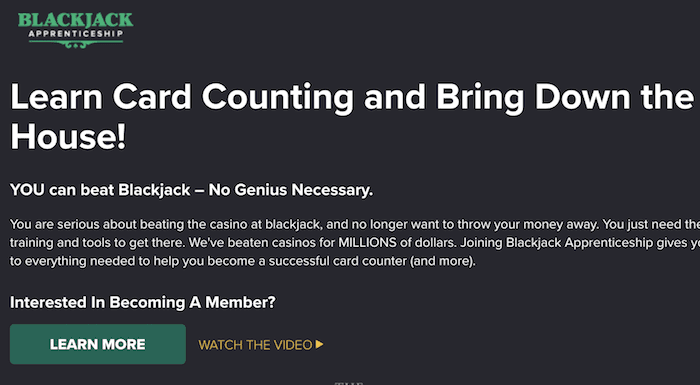
How to monetize a blog with membership sites:
First, you must have content worth paying for. If people don’t think it’s valuable enough, or if it’s just glorified blog content…you’ll have a hard time finding sales.
Next, you’re going to have to put software in place to restrict access to member content. More on that below.
Last, you need to KEEP making it worthwhile for people to be members. This means adding content consistently. That’s a TON of work probably.

My membership community, Online Impact, was built because I realized JUST selling online courses didn’t actually lead to much success.
A lot goes into membership sites!
Resources and tools for setting up a membership site:
If you’re looking for a profitable (but more difficult) way to monetize your website, but want MORE than a stand-alone course…a membership site is what ya want. I’ll say this again, you absolutely need content worth paying for though.
There are definitely easier ways to monetize a blog on WordPress…but this can be INSANELY lucrative if you nail it.
The ONLY reason ‘flipping your blog’ is an actual way to monetize…is because there are actually a ton of people who do it professionally.
In fact, there are people out there who start “niche websites” or “authority sites” with the sole intention of selling the blog once it starts getting traffic and ad revenues.
(Want to listen to my podcast episode with THE niche site master himself? Click here)

FAQ: At what point would somebody sell their blog? Websites that generate significant traffic are worth money. While there is no minimum traffic for selling a blog, you won’t be able to sell for much until you are generating traffic capable of earning a few thousand dollars a month…even if it is NOT currently making that!
Since we’re learning how to monetize a blog…that implies we’re actually going to keep the blog, so we won’t spend a ton of time on this.
Still, just know that at some point down the road, if you blog consistently and start ramping up traffic, blog ad revenues, etc…you likely could find a buyer!
Private Label Rights (PLR) really just means “pre-made content people can just BUY, then use however they want.”
People need content, are too lazy to produce content, and also too lazy to hire and manage freelancers? They buy PLR.
And folks like US could potentially sell our content to them. There are TONS of legal stuff to this, as well as competition, but it can be done I suppose. My thoughts? Don’t bother lol. Better ways to make money.
Don’t underestimate this…
There is NO quicker way to make money online than through freelancing!
Sexy? No.
Profitable? Yes.
This might be a little controversial…as you technically WON’T be monetizing YOUR blog…but rather making money from other people’s websites, etc.
(Although I’d argue it’s still very much utilizing blogging skills, and you wouldn’t be able to get these profitable freelance gigs WITHOUT a blog of your own!)
Important: Personally, I recommend freelancing 1,000% percent.
Freelancing is the fastest way to make money blogging. Period. In terms of overall revenues, no other blog monetization method comes close in the *short-term.*
The reason? For almost all other ways to make money…you need to spend time building traffic and cultivating a following! (who will pay you money).
For freelancing, you need only match up your skills with other bloggers willing to pay you to perform them…of which there are plenty.
At the time of this writing, I still maintain 3 freelancing clients, which earn me anywhere from $1k to $3k a month. I would NOT have found these gigs if I hadn’t started this blog.
Nick True from Mapped Out Money runs his own blog and YouTube channel, but actually makes full-time income from only 2 blogging clients.
One of my Online Impact students, Melody, made close to six figures in her first year–largely thanks to getting freelance clients!
(she used that income to leverage an audience to sell her own products now).

Here’s how to make money in freelance blogging and writing:
1 – Figure out what you’re good at
What skills do you have, or are really keen on improving on? You DON’T need world-class freelancing skills in order to make some money! You just need to find 1 or 2 skills you enjoy working hard at and learning about.
Can you run Facebook Ads? Make pretty Pinterest images? Organize schedules and manage inboxes as a VA? Can you write more good?
#jokes
All of us have something to offer other bloggers, it’s just a process of finding what that is and matching it with what other people need.
Personally, I’m a freelance writer. It pays well and allows me to build backlinks to my own blog!

2 – FIND the people willing to pay you for your services
First, here’s a great post for finding freelance writing gigs. You’ll see several “marketplaces” for people looking for freelance bloggers!
However, those can be quite competitive, as can HUGE freelance sites like Upwork, etc. You won’t make much blogging money from these.
Rather…focus on this:
3 – Pitch them and build relationships
🙂
Though it’ll initially take longer, focusing on building REAL friendships in your communities WILL make money over the long run, and this could very well mean freelancing income as well.
Pro Tip: When pitching for freelance work, always ask for things HONESTLY and transparently. Furthermore, asking for referrals is far more powerful than asking for. things directly! Also, send follow-up emails and be persistent.
Jillian from Montana Money Adventures is a blog coach AND money mentor…and has more inbound requests that she can handle.
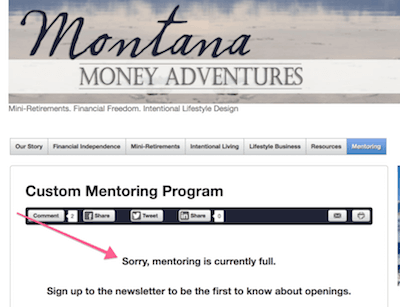
Whether you blog about gardening, the ketogenic diet, or personal finance…there will always be individuals who want 1-on-1 help, and are willing to pay for it!
However, you can’t just start a blog one day and hope to make money coaching the next. Why should people trust you? You need to build up that “authority” first.
DYEB Recommends
You may not want to hear it, but I don’t think anybody should start coaching their readers until they’re being asked to. If you really have to sell it, you’re not ready yet anyway.
However, it couldn’t hurt to create a separate page on your website where readers could browse through your different service offerings. A “coaching” or “hire me” page could make money one day.
If you’re blog is currently hosted on WordPress.com, you’re sadly limited by how you can monetize (you can’t display ads unless you’re on a premium plan).
You’re also slightly limited by what plugins you can use (which could help you monetize via membership sites and online courses).
If you’re currently hosted elsewhere (but still using WordPress as your CMS), you can monetize with ads, affiliate marketing, sponsored, posts, and any other method.
Yes! There are several monetization methods, including ads, affiliate marketing, digital products, etc. All of these methods are accessible, but you will still need a a decent amount of blog traffic (and trust with your audience) in order to monetize a blog.
Most bloggers in their first year earn very little, mainly from ads and affiliate marketing.
However, it is possible to start growing between $50-200 a month within your first 24 months.
Once your traffic reaches higher numbers, it isn’t uncommon to start earning more than $1,000.
Bloggers at the highest levels can earn over $50,000 a month, usually through a mix of affiliate marketing and launching their own digital products.
Using the WordPress software on your own hosting account (meaning you purchase hosting from a 3rd party provider, like Bluehost, GoDaddy, or Siteground) is the best platform for making money from a blog.
WordPress gives you the most flexibility to experiment with different monetization models, including affiliate marketing, running your own membership sites, and selling online courses.
There are several bloggers who earn over a million dollars a year, just from their online platforms (including blogs).
These include…
Beginner bloggers are most likely to start making money via two ways:
Starting a blog for free, using sites like WordPress.com, Medium.com, and Blogger.com, can eventually lead to making money (mainly through affiliate links and selling digital products like online courses or eBooks).
However, paying a hosting provider to host your own blog does offer more flexibility and customization, which could make it easier to monetize your blog.
Display ads, affiliate marketing, and selling digital products (namely online courses) tend to be the simplest methods to start earning income from a blog.
Even for new bloggers, the revenues from these can generally make up for the annual costs of domain names and hosting accounts, turning a profit!
If you’re really looking to make money blogging, you should know that it takes WORK.
There IS no get rich quick option, nor is there any one “best” way to monetize a blog. You’ll have to figure some things out for yourself!
In fact, the ACTUAL best blog monetization strategy is to constantly try different things out until you find what works best for YOU. Then double and triple down on that.
So what will it be for you?
Leave me a comment below and share what strategy has brought you the most money from your blog! If you’re a new blogger, what are you most excited to try?


This website uses cookies to ensure you get the best experience on our website.
80 Responses
Wow this is quite the post – definitely going to add this as a resource to my personal collection of blogging resources, but also link back to it to help you out 🙂
Whhhhhat thanks Erik!
I appreciate that 🙂
(no joke. After I read your net worth article today, I put you on a list of people to reach out to for backlinks >_< I shall NOT pitch you that email now lol) #blogging
I completely agree with that! Amazing content 🙂
Thank you, kind sir! 🙂
MEGA POST!!!
Seriously, awesome content Pete! This gets a share!
haha yay thank you Mike!
I do enjoy a good share 🙂
That’s an amazing article on monetization, It’s really helpful for as I’m a newbie in affiliate marketing your article really help me to choose which one is better for my sites.
Glad to hear it TtR!
(I always refer to folks by their abbreviated site name)
🙂
Thanks Pete !
I needed this so badly! Thanks!
yeah? I’m happy to have put it in front of you Yetunde 🙂
Good luck monetizing!
Whoa! Great stuff here. Thank you for the comprehensive (and inspiring!) share.
Definitely going to be checking out the sponsored posts podcast from Mike Loper you reference. Really starting to get a lot of requests and I have no idea what to charge.
It’s an amazing one, but his name is Nick Loper, not Mike 🙂
(and now I’m wondering if I mistyped it above. Gonna go check)
Great post Pete! How long did it take you to write it?
Going on month 9 and still barely getting any traffic and no engagement. But keep trying, right?
Great question. Maybe about 15 hours in total? Maybe more like 20-23 actually.
And email me a few more stats and metrics CJ. Let’s see what we can do.
Great post! Now, how about one for reading Google analytics and other metric-based sites that look like a different language with pretty pictures? 🙂
Aw, man. You’re raining on my membership site parade, Pete.
I used to make most of my money designing and building websites for people. For about a thousand and one reasons, I wound up hating my business. I shut it down last October, then launched a new thing that’s more heavily focused on content than services, and fellow misfits and mavericks instead of traditional businesses.
I’m liking it way more, but not yet earning enough to even buy dog food :/
I have implemented some of the monetization strategies you mention (small services, affiliate networks & single program affiliate links), but I don’t have the necessary traffic (yet!) to make the passive stuff pay. I’m already doing video walk-throughs in a private FB group & getting positive feedback. I thought this might translate into a membership site of some sort.
I do need to figure out whatever it is that will pay the bills, but the membership thing is so attractive b/c it’s a super-cool way to help people like I do in the FB group. The big difference, besides possibly charging for membership, is that I could actually engage them more than FB allows.
Would love to nail this, as you put it. I’d even settle for “lucrative” instead of “INSANELY lucrative.”
Very nice synopsis and well laid out. I’m fasinated with all the blogs making a killing every single month! I’ll definitley bookmark this one for later. Cheers.
Thanks Michael. Me and you both, it’s the only reason my podcast exists 🙂
I love how comprehensive this post is! It’s nice to have one piece now that I can always refer back to instead of having to Frankenstein together a bunch of different articles.
Why thank you Kate! That was the ultimate goal really (and probably should be for all SEO hopeful posts)
🙂 Thanks for being here, I appreciate you!
I read this when you published on Monday and bookmarked with a note to come back on the weekend to re-read. Well I didn’t wait for the weekend and re-read this today while eating my lunch.
Such a comprehensive list but fine-tuned with the usual Pete & DYEB laser focus. I am about 10 weeks into my own blogging journey (and $117 in revenue…haha) but this type of resource is evergreen and will continue to deliver value as time passes and the MM blog grows so that I can better implement some of these strategies.
Adding to the Momentum’s Finest roundup tomorrow!
Cheers,
Scott
When I first started blogging (in 2007) I monetized my blog only with ads and some services that I stopped providing after a short time. For a few years I made a good income just on ad revenue, but there was always constant pressure to keep traffic increasing. After I added some other revenue streams like selling digital products, affiliate programs, and membership, my income increased pretty rapidly. Selling digital products has been my favorite way to make money from a blog for the past few years, but if does require some work.
Thanks for the great article Pete.
De nada Marc!
This is a great roundup – I love how it’s clean and easy to use. My question with affiliate blogging (and one I can’t seem to find an answer to, no matter how I structure my query), is, what is the best way to handle the tax portion of the affiliate program applications? And then, how do you structure your bank accounts and manage purchases for blogging and paying yourself? Thanks for any insight you can provide!
Just wanted to follow up as I can’t seem to find great resources on the personal finance side of blogging! When you set up your affiliate accounts, how did you file (individual contractor, as an LLC, etc.)? I just want to make sure everything is completed correctly at the beginning rather than dealing with things after an issue arises!
Bah sorry Krystal! This one slipped by me.
For tax purposes, an entity really doesn’t matter, as whatever we’d (99% of bloggers) would do is create a pass-through entity (so we’d only get taxed once on earnings), i.e. a single-member LLC or sole proprietorship.
Takeaway? Be a sole proprietor 🙂
This would mean forking over your SSN instead of an EIN, etc.
As far as bank accounts, I’d say don’t change anything, add new accounts, etc–until you’re making $20k-30k a year. Just keep your receipts from all blogging-related expenses, and add all that up on your individual tax return (schedule C)!
Once your business is to the point of making enough income to warrant financial statements, or spending enough so that it’s really hard to keep track of–creating separate business accounts might make it much easier.
Hope that helps!
Hey, great post. Quick question, how did you develop the table of contents? Do you use a plugin? If so, which one? Thanks!
Nope! No plugin!
I interlinked using CSS ID’s (i.e. domain.com/some-post#chapter2)
That, and custom CSS formatting like this: https://youtu.be/LyUzyLt8wt0
2nd question:
Would you be interested in reading a tutorial on this? I think one other person asked as well.
Thanks for clarifying. Yes, I would be interested. Thanks!
Wow. Really nice article 🙂 Good job!
Thank you 🙂
Hi Pete, awesome information collection! Thank you for sharing. Looking forward to trying some of these money making options.
But of course! Thank you for coming here and commenting 🙂
This is an incredible post. I’ve got so many tabs open right now just from this one post! Looking forward to learning much much more. Thanks for sharing!
Well you are more than welcome Emily, and I appreciate that 🙂
Thanks for being here, and good luck sifting through the tabs!
I needed this Thanks for useful information
de nada!
Nice post! I’m proud to say that I have managed to create my very first blog post for my website, and I’m excited to put everything aside to make this work. I have been doing guest post outreach for businesses and bloggers for while before I decided to create my own site.
Thanks for the inspiration and the value you provide 🙂
Aw. That’s very kind of you Angeline, and I’m happy to hear that!
Keep up the good work, and keep me posted 😉
Hey~ Just wanted to say thank you for what you do! I love listening to your podcast. It gave me the push I needed to keep going and working at this crazy blogging thing.
There isnt much to look at but check me out at darcilou.com if you would like!
yay! Thank you!
That makes me feel good 🙂
and please do–Yes, it’s crazy, difficult stressful, etc–but can also just be fun and rewarding (if we let ourselves celebrate the small wins).
Let me know if you need anything! Checking it out now.
Another great article! Quick Question: Do you recommend WooCommerce? As I read the section on ebooks, I didn’t see any recommended products/tools fore commerce. Looking forward to hearing your thoughts! Thanks, Pete!
Margo
Hey Margo! It depends on what you’re selling probably–and the level of advanced features you need.
If you just need the basics of ecommerce–Woo is fantastic. The big downside with them is you have to pay for advanced features separately via add on plugins.
It is a fantastic free option though!
Thanks, Pete! That is what I needed to know. Appreciate your insight!
I don’t even know the way I stopped up here,
however I thought this post used to be good. I don’t recognize who you
might be but certainly you’re going to a well-known blogger in the event you aren’t already.
Cheers!
Well I’m certainly happy you did! And I appreciate that 🙂
This is so needed and extremely helpful. THANK YOU, you’re awesome!
Well you’re welcome! <3
vary good post.
Hi, I recently started listening to your podcast and really like it so far. Two things on this post: 1) the two links I wanted to click through to were for the Penny Hoarder but I’m in the UK and got a message saying I couldn’t see the site in this country – any other way to see what you were linking to? 2) just to let you know the images on this page aren’t showing up right on an iPhone 8plus (they basically stretch across so to see them all you’d have to scroll all the way to one side if that make sense?). I’d want someone to tell me if it was my site so I thought I’d let you know. Thanks for all the content! Kristen
Bah sorry about that Kristen!
I’m actually working on republishing this one right now, actually, and will take care of those image issues 🙂
And I don’t think there’s a way for you to get on TPH unless using a VPN. They’re probably blocking all EU traffic due to GDPR issues 🙁 🙁
Whoa! Great stuff here. Thank you for the comprehensive (and inspiring!) share.
Definitely going to be checking out the sponsored posts podcast from Mike Loper you reference. Really starting to get a lot of requests and I have no idea what to charge.
It’s totally worth it. Great episode. Thanks, fellow boxing lover! 🙂
Fantastic content! I’ll safe this page and will definitely link it to my blog so other can learn from you as well.
Many thanks!
Of course! Glad to help.
This was very helpful! Thank you.
You’re welcome!
Hi Admin,
Thanks for sharing such an awesome article, keep posting more of these.
Awesome content
it is not good to depend only 1 income source. Adsense is the best program we can earn some good money from our blog.
Selling ads and sponsored posts are what works best for my main blog. Thanks for the share!
Keep Sharing
Hey, this is a great blog. You explained everything really well. I enjoyed reading this guide. Your readers will surely appreciate you for composing this guide. Bookmarking this. Keep the good work up 🙂
Thanks Team K 🙂
Giveaways are another way to make money blogging. While it seems like you d be spending money giving away a prize, there are ways to monetize the audience. Some giveaways have entry options where you re required to visit a website to get a point. There have been bloggers who add an affiliate link to Amazon for that option, earning a commission in the process and covering the cost of the prize. You can also earn a commission or payment if promoting the giveaway of another brand making it a sponsored giveaway. Another option that an online retailer, with a blog, could do to monetize giveaways is send a runner up prize to all the people who ve lost the giveaway. The prize? A discount to your online store. Thus, making the giveaway profitable instead of an expense.
The biggest asset a blogger owns is his or her audience. With regular traffic to your blog from search, social media, or your email list, you own the one thing everyone wants: customers. If you want to make money blogging, adding an online store to your blog can be a life-changer. If you re a fashion blogger, you can find the latest men s and women s fashion on Oberlo. Heck, if you re a blogger in beauty, home decor, maternity, children, DIY, photography, and basically every niche on the planet, you can find products to sell from Oberlo. The magic of dropshipping lies in your ability to sell products without having to buy bulk inventory so you only buy what you ve already sold. And with your website already set up, you can add hundreds of products (for free).
When people start internet marketing for the first time, they may face some problem like Website customization, SEO and monetization etc. I love expert marketers share their experiences and inspire newer to work professionally.
Love your tips, this is so helpful.
One mistake that a lot of people probably make is picking the wrong niche. There is a formula to pick up a new niche. Don’t pick up a niche that already has very large competitors. So one of the rules, if you want to be successful is to check the parameter, whether that niche is competitive? Does this niche have a future, can you see trends?
Another test I ask my readers to take is can you come up with at least 20 articles when you are coming up with a niche.
Analyze how many advertisers are in that niche? How much they are willing to pay? CPC is a good way to measure that.
Like!! Really appreciate you sharing this blog post. Really thank you! Keep writing.
Great job
Thanks! For this informative article. I would surely forward it to my group.
Awesome post! What I love is the site’s simplicity! I have a few quick question, how and what do you use to create the fun comic illustrations? And how do you change font/highlight color/custom buttons?